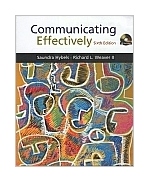Communicating Effectively
has been written for the student who is taking a speech communication class for the first
time. We show the theories of interpersonal, group, public, and intercultural
communication and how they apply to real-life situations at school, work, and recreation.
The first part of the book is devoted to the principles of communication. Chapters 1
through 5 present a model of communication and show how communication works, both verbally
and nonverbally, in our encounters with others. In Chapters 6 and 7, we discuss
interpersonal relationships, their dynamics, and how they can be improved. In Chapter 8,
"Communication at Work," we discuss informational interviews, informational
interviews as precursors to job interviews, and presentations. Chapter 9 and 10, on small
groups, look at decision-making groups and how groups can solve problems. Chapters 11 to
16, on public speaking, teach how to develop, organize, and deliver a speech. A full
chapter, the Appendix on "Mass Communication and Media Literacy," focuses on
mass communication and specifically on the Internet and the World Wide Web (WWW). It
examines the relation of media to the communication model, the reasons for studying media
literacy, and how to assess information in general, information found on television and in
newspapers, and information on the Internet. There is an additional section on the
importance of ethics.
We use many examples of key concepts in this book because this is the best way to bring
the theories to life. We draw these examples from familiar experiences of work,
interactions with others, and campus life.
One of our greatest goals is for the text to present the world beyond our local
communities. Both of us have lived and worked in many places that are completely different
from the United States. These encounters with different cultures have given us many
experiences to draw on in discussing what happens when people try to communicate across
the boundaries of their own ethnicities or nationalities.
We also have a strong focus on subcultures within the United States. We discuss race,
class, and ethnicity. For cross-cultural and intercultural communication, we draw on
theories and examples from both the United States and the world. At several points in the
book we challenge our readers to see beliefs and values from the perspective of a culture
that is different from their own.
A final goal that we have pursued throughout the book is to connect readers to the
Internet and WWW. Woven into the fabric of every chapter, we interlace specific "On
the Web" boxes that ask readers to respond to Web information, access specific Web
sites, evaluate Web material, or view related information carried on the Web. Web
readings, too, are included in the Further Reading sections of each chapter. Chapter 12,
"Finding Speech Material," has been oriented to using the Internet in a section
called "A Guide to Researching on the Web," as both a learning and researching
tool. Finally, the Appendix, "Mass Communication and Media Literacy," is
designed to underscore the need to both study the Internet and WWW and their effects, and
to be able to competently and efficiently assess the information found on television, in
newspapers, and on the Internet.
NEW TO THIS EDITION
Our Rich Heritage
With the explosion of new technology it is sometimes easy to forget the rich and lengthy
heritage of speech communication. We open Chapter 1 with a look at its history from
Aristotle, Cicero, Quintilian, and St. Augustine to the use of chat rooms and email.
Presentations
To Chapter 8, "Communication at Work," we have added a new section on
Presentations that applies to anyone having to make a presentation. In this section we
discuss the importance of thorough preparation, natural delivery, and effective visuals.
We make specific recommendations for both the preparation and presentation of visual
support.
Communicating at Work
We moved the prior edition's appendix on "The Interview" to the end of our
section on interpersonal communication. Chapter 8, and we oriented the chapter toward the
workplace. We added a section on the interview formats of open, closed, and semi-open. We
include a sample informational interview on the use of the Internet as a research tool.
There is a new section on "Interviews as Precursors to Job Interviews," a new
box on "Researching Jobs on the Internet," new suggestions for developing
resumes, and guidelines for preparing computer scannable resumes. Our "Cover
Letter" section now includes both letters of inquiry and letters of application.
There is a new section on behavioral interviewing, and a new section, as noted previously,
on presentations.
"Mass Communication and Media Literacy"
The Appendix, focuses on mass communication with special emphasis on the Internet. We
examine media literacy, how the media relates to the communication model, why the media is
worthy of study, and how to assess it. Our assessment section looks at evaluation of
information in general, information delivered via television and newspapers, and
information found on the Internet. The chapter closes with a section on ethics.
648 pages
Księgarnia nie działa. Nie odpowiadamy na pytania i nie realizujemy zamówien. Do odwolania !.


